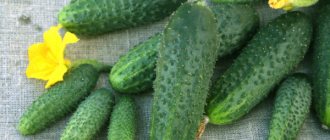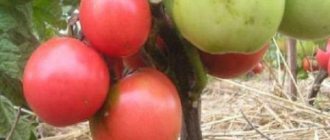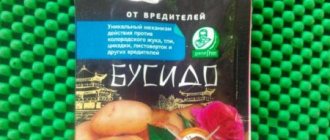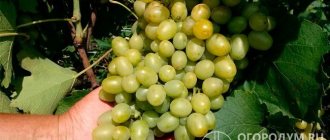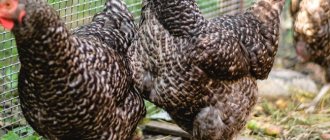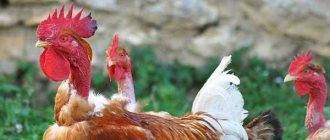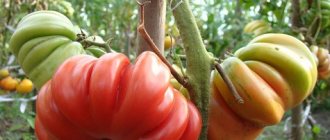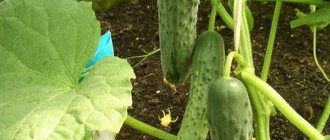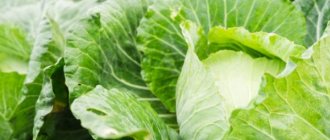Description
Armenian cucumber is an early-ripening crop. From the moment the seeds are planted until the harvest, no more than 80 days pass. In regions with a warm climate it is grown in open ground, and in cool climates - in a greenhouse. Bee-pollinated variety. On the one hand, this allows you to harvest seeds yourself, but on the other hand, it creates difficulties when growing in closed conditions (it requires either providing access for insects or carrying out artificial pollination). The crop is grown both by seeds and seedlings.
Reviews from vegetable growers
According to the experience of gardeners, who have been growing Armenian cucumbers in their garden plots for several years now, the soil before planting should be very carefully dug up and fertilized with humus at the rate of 1 bucket for each square meter of planting. It is also recommended to add approximately 0.5 buckets of sand per square meter. In the last ten days of May, the seeds should be soaked for a day in a solution of a growth stimulant, and then planted in open ground at a distance of 0.7 m.
Externally, Armenian cucumbers resemble slightly wrinkled and pubescent zucchini. The fruits are collected without allowing them to overripe, with a length of no more than 25-30 cm. Reviews from vegetable growers characterize this garden crop as having very unusual taste qualities. The fruits are not only eaten fresh, but also stewed, salted and pickled without peeling the skin.
Armenian cucumber: growing in a greenhouse
After 2-3 true leaves appear on the plants, you can transfer them to the greenhouse beds. The soil composition for adult plants is the same as for seedlings. The soil should be as loose as possible. This variety tolerates saline soils calmly - the yield does not decrease.
In the greenhouse, you must first install reliable supports for the vines. The beds themselves should have a width of 1 m and a height of at least 25 cm. If desired, Armenian cucumbers can be grown in central Russia and in open ground. In this case, the lashes, as a rule, are simply spread along the ground, as with ordinary cucumbers. But the maximum yield of this “melon” variety can only be obtained when grown in a greenhouse.
When transferring seedlings to a permanent place, you should be as careful as possible. Under no circumstances should the roots of the Armenian cucumber be damaged. Otherwise, the plants will take a long time and take root poorly. Seedlings should be planted together with a ball of earth. To make it easier to remove it from the cup, the plant should be thoroughly filled with warm water a day before transferring. Next, the bottom of the pot is simply cut off and the lump is squeezed out. The first few days after transplantation, young cucumbers should be shaded.
Reviews from gardeners
“I am an experimental gardener, so all new cucumbers always appear in my garden. The Armenian cucumber “Bogatyr”, a photo of which I saw on the Internet, was no exception. I became very interested in this exotic plant, so I began to look for information about it. I read the characteristics of the variety, reviews, and firmly decided that this miracle vegetable should settle in my beds. No sooner said than done. I ordered seeds and planted them in the ground in early spring. They rose together and very quickly. I cared for them like ordinary cucumbers and soon received the first fruits. The taste is unusual - either melon or cucumber, but my family really liked it. All summer we ate delicious salads from young cucumbers, and the big ones were put into canning. I will definitely plant it next year, and I recommend everyone to try it.” Svetlana, 48 years old.
Growing
Armenian cucumber seeds are sown in the soil only after it has warmed up to +15-25 °C. It usually reaches this temperature in the second half of May. To ensure that the seeds germinate together, they are soaked in water with a root formation stimulator. At suitable temperature and air humidity, the first shoots appear within a week. In areas with a cool climate, the crop is grown by seedlings at the end of April. To avoid diving, seeds are planted directly in cups.
Experienced farmers prefer to buy seeds that are coated, which contains pesticides and nutritional components. They do not need preliminary preparation, so they are immediately planted in the soil. Treated seeds germinate better, and the plants grown from them are less sick and ultimately produce a generous harvest. Some gardeners independently collect seeds for further planting. To do this, choose a large, healthy and fully ripe fruit. Using a spoon, remove the seeds from it, wash them under running water and spread them in a thin layer on a napkin. Afterwards, the already dried seeds are placed in a glass container. Their shelf life is 3 years.
The Armenian cucumber tolerates slight soil salinity and grows in clay soils. It produces a good harvest when grown on fertile lands with low moisture levels. However, the most suitable soil for it is light and loose. Sunny areas are chosen for growing crops. Exposure to ultraviolet rays in this case does not cause harm, but, on the contrary, stimulates growth. Before planting, the soil is dug up and leveled. All weeds are removed along with the roots. When the soil is significantly depleted, mineral fertilizers are applied.
Attention! If the seed material is collected with your own hands, it is checked for quality: immersed in a container with a weak solution of potassium permanganate. The floating seeds are unsuitable for use, so they are thrown away.
The procedure for planting a cucumber is simple. Place 2-3 seeds in each hole to a depth of 5 cm. At the same time, maintain a distance between holes of at least 70 cm, and between rows - at least 150 cm. When planting seedlings, adhere to the following agrotechnical practices:
- make holes of shallow depth;
- a seedling is placed in the center;
- the roots are sprinkled with soil, but do not compact it;
- water abundantly.
It is worth noting that seedlings are transplanted to a permanent place only after 6-7 true leaves grow on it. If this is done earlier, it will be difficult for the plant to adapt to the new environment. Since the procedure is carried out after the threat of frost has disappeared, the plants do not need shelter. When growing crops in greenhouse conditions, carefully monitor the microclimate. Dry climate has the most favorable effect on Armenian cucumber.
How to grow Armenian cucumber
Despite its unusualness and novelty, the culture has no special requirements. The basic rules for planting and care are similar to any other plants. Whether you grow snake melon outdoors or in a greenhouse, the results will be approximately the same. A greenhouse has one advantage: a more uniform climate and the ability to regulate it. Since the plant came to us from warm countries, the temperature for growing should be comfortable.
Snake melon can be grown indoors or outdoors. Unlike conventional varieties, too high humidity is not needed: it will more likely harm the plants than benefit them. The fruits are removed from the bushes along with the tail, otherwise they will not be stored well and will spoil faster.
Interesting!
If you store ripe fruits in the refrigerator, they will retain their taste and aroma for a month after picking.
Seeds
Serpentine melon seeds do not have fruit membranes, so a fermentation process occurs. When removing seeds from fruits, rinse with clean water and dry. Before planting, you can store them in a cool place in paper packaging, tightly closed. There is no need to disinfect, otherwise the solution may damage the structure without the shell. You need to germinate seeds in the same way as regular cucumber seeds. It is best to plant seedlings rather than in the ground: this way you will avoid risks of frost and ensure sustainable growth of seedlings.
The optimal time for planting seeds for seedlings is the second half of April. The seeds need to be buried deeper, at a distance of about 5 centimeters. Water as needed and make sure the plants get enough light. The first shoots will appear in a week.
Interesting!
You can speed up the germination process by treating the seeds in a growth stimulator for several days. After this, seedlings will appear faster by a couple of days.
Landing in the ground
You can move the seedlings to the mainland after the fourth pair of leaves appears. You can plant them in closed ground or under film in the second half of May, but with open ground you need to focus on the weather. The air temperature should be about 25°C, and the soil should be warmed up to 15°C. It is better to place up to 4 bushes on each square so that the plants feel spacious.
Interesting!
Crop rotation is a must, which also applies to snake melon. You cannot grow plants in the same bed for more than four years. Try to renew the soil and move crops around the garden, alternating with other crops.
The soil must be prepared first. Clear of plant residues, fertilize with minerals so that the cucumbers have something to eat. Superphosphate and organic matter are suitable. If you grow a plant in a greenhouse, be sure to treat all surfaces, walls and crossbars with a disinfectant composition: fungus can accumulate on them. Light and fertile soil is suitable for cultivation. Before planting the serpentine melon, it is recommended to fertilize it with humus and mix it with sand, adding half a kilogram to each square.
Caring for Armenian cucumbers
The plants are unpretentious: the same care as for cucumbers or melons is suitable for them. The only major difference: humidity. Snake melon is accustomed to a dry climate, so it is better to control this indicator; it should not exceed 50%. This variety grows best in dry, warm climates.
You need to water the plants with warm water so as not to chill the roots and damage them. It is best to water in the evening, right at the root. In the sun, moisture evaporates faster and watering is ineffective. Excessive watering is harmful, as is lack of moisture. Make sure the soil is moist but not wet. When the first signs of wilting, yellowing leaves or brown spots appear, indicating a lack of nutrients, add complementary foods to the watering. Moisture is needed regularly, so if it is not possible to take care of the plants several times a week, organize automatic watering or mulch the soil. Mulching will help increase the nutritional value of the soil, so on mineral-poor soil this method becomes especially relevant.
Interesting!
Cucumbers can be planted in heated greenhouses much earlier. If you can maintain the indoor heat level above 25°C, plant without fear.
If you planted an Armenian cucumber in the ground, and immediately after that frost hit, cover the crops with film. This will help keep you warm. An alternative is mulching with organic or inorganic material. Monitor soil moisture: if there is no access to air, the process of rotting and the development of harmful microorganisms may begin. Regularly clear the beds of weeds and debris so that the plants can develop peacefully.
You may be interested in:
Fighting spider mites in a greenhouse on cucumbers If you are interested in the question of how to get rid of spider mites on cucumbers in a greenhouse, you should familiarize yourself with folk...Read more...
Loosening is a mandatory part of the care program. It improves aeration, giving the roots access to air, and at the same time makes the soil more homogeneous, evenly moistening the layers and distributing micronutrients. Feeding requires sufficient amounts of nitrogen, potassium and phosphorus. The first mineral is responsible for the rapid growth of the green part, potassium and phosphorus help the fruits to form and saturate them, improving the taste and making them more juicy. Complementary feeding should be done once every 10-14 days. Moisten the soil well before applying fertilizer.
Care
The usual care for the Armenian cucumber is:
- Watering should be carried out only with water at room temperature and preferably in the evening. It will probably allow the root system to stay longer in a humidified environment and obtain the required amount of water.
- Loosening the soil is necessary so that high-calorie preparations and moisture can better pass to the root system, especially since crust on the ground can lead to rotting of the roots.
- When weeding the beds, it is necessary to eliminate all weeds that can interfere with the correct formation of the bush or fruit.
Armenian cucumbers require proper feeding with mineral fertilizers:
- It is preferable to use only phosphorus, potassium and nitrogen compounds.
- Nitrogen will allow the plant to form faster, and as a result, the fruits will ripen faster.
- Potassium and phosphorus will help the fruits gain the desired weight and shape, and will also fully reveal the mind-blowing taste of vegetables.
- Feeding with these drugs should be carried out alternately, with an interval of 10 days. It is better to only apply fertilizer a certain number of days before watering.
Choosing a suitable variety of cucumbers for growing in open soil in the country or at home on the balcony is very difficult. In this article you can learn how to choose the right variety for growing and which cucumbers are easier to care for.
Productivity and Benefits
The yield of the hybrid is increased - up to 7-8 fruits can be harvested from one vine, which is a very good indicator, considering the size of the cucumbers. In one season, you can collect up to 11 kg of harvest from one plant.
Advantages of the variety:
- good tolerance to cold and drought;
- temperature stability;
- disease resistance;
- ease of care;
- high productivity;
- excellent germination;
- unusual look, great taste.
Care
Since the Armenian cucumber does not like excess moisture, it is watered abundantly, but infrequently. In dry and hot weather, this is done about once a week. If there is periodic precipitation, the frequency of the procedure is reduced to twice a month. Water the plant with settled water heated in the sun. The use of cool liquid is unacceptable. This can lead to plant stunting and reduced yield. Water Armenian cucumbers at the root, trying not to wet the tops. Getting water on the leaves can lead to the development of diseases. To help the soil retain moisture longer, it is mulched. To do this, use straw, rotted compost or dry leaves.
The most commonly used fertilizers are:
- Vermicompost is a natural fertilizer that contains many macro- and microelements, phytohormones and amino acids. They are fertilized once every 10 days before fruiting begins.
- Humus. It contains substances necessary for the growth, development and fruiting of the plant.
- Nitrogen fertilizers. The Armenian cucumber needs them most before flowering.
- Phosphorus-potassium fertilizers. They are needed for the formation and ripening of fruits.
In order for the plant to grow well and develop properly, gardeners regularly remove weeds. Grass takes moisture and nutrients from the ground and shades the crop. The soil is loosened at least 2 times a week. After this procedure, oxygen enters in greater quantities to the root system and it becomes stronger. To prevent the fruits from contacting the ground, wooden trellises are installed and shoots are directed along them for vertical growth.
Care
Armenian cucumbers need care.
This is systematic digging up of the soil for better air exchange, ventilation of the root system, removal of weeds to additionally free up space for the necessary seedlings, and rare but plentiful watering. Vegetables love fertilized soil and additional nutrients from outside, so fertilizing is indispensable. Organic substances will do. But during the period of active growth of the bush, organic matter should definitely be mixed with a complex of mineral substances. Preference should be given to phosphorus, potassium and nitrogen fertilizers:
- nitrogen is used for the formation of the bush and further fruiting, and high yield;
- potassium and phosphorus - proper weight gain and taste characteristics for Armenian vegetables.
The attached list includes the following types of additives:
- a mixture of equal parts of potassium salt, ammonium nitrate and superphosphate;
- a solution of urea, potassium sulfate and superphosphate (sulfate in a ratio of 1 teaspoon per 1 bucket of water);
- mullein tinctures with the addition of ash;
- additional tincture of mullein with chicken droppings;
- slurry.
Watering is advisable once a day and exclusively with heated water. Cold weather can negatively affect the absorption of moisture by the root system of the plant and affect fruiting. It is necessary to avoid the penetration of water onto the leaves and stems themselves, especially during the daytime. There is a risk of getting burns on the thin peel of cucumbers.
Advice! Before the first ovary appears, you can spend up to 4 liters for every 1 m2. During fruiting, it is advisable to increase the volume of incoming liquid.
Silver melon does not require pinching or tying up lashes and whiskers. It is advisable not to allow the fruits to overripe, otherwise cucumbers that are too large may lose the charm of the tenderness of their thin skin and pulp. They begin to cut the fruits at the growth stage of 20-30 cm. The general collection is carried out at least once a day, more is possible. It is preferable to pick the fruits together with the stalks, this will increase the shelf life.
Typically, cucumbers of this variety do not lose their quality for 30 days. To continue this gap, refrigerators and cool places will also work.
Varieties
Sowing seeds
Growing a miracle cucumber is not particularly difficult. True, for the successful development of a crop, high temperatures of both air and soil and a sufficient amount of sunlight are necessary.
Seed germination is possible if the temperature does not drop below 14 degrees, and seedlings will appear about a week after sowing. The optimal time for sowing in open ground is the last ten days of May, provided that the weather is warm enough.
The seeds are placed in prepared, well-watered holes, 2-3 seeds in each, to a depth of about 5 cm.
If you want to try to prepare seed material yourself (since it is quite difficult to find seeds for sale in our country), select fully ripened fruits for these purposes.
The selected seeds are placed in a sieve and washed thoroughly under running water. After this, the seed material must be dried and stored in a paper envelope.
Subject to optimal storage conditions, germination is maintained for several years.
Crop care
As already mentioned, the serpentine melon is absolutely not whimsical. All it needs is regular loosening of the soil, removal of weeds and rare but fairly abundant watering.
To feed the crop, it is recommended to use organic fertilizers, preferably liquid mullein. Many gardeners do without fertilizers at all: as practice shows, this melon grows successfully on any soil.
In addition, the plants do not need tying up vines or pinching.
The variety is considered resistant to diseases and infections and can be affected by common garden aphids.
When the melons are ripe, pick them from the bush along with the stalks, so the shelf life of the fruits will be slightly longer: on average, they retain their presentation and taste well for about 30 days.
Serpentine melon is loved by gardeners for its long fruiting period, resistance to temperature fluctuations and common infections, as well as for its high yield.
Be sure to try to grow such an unusual vegetable in your garden, and it will definitely become a regular guest in your beds.
Video "Growing"
From the video you will learn how to grow such an unusual root vegetable.
There are two main reasons for such reviews: unscrupulous producers who allow mis-grading, and gardeners who draw conclusions from one unsuccessful experiment.
If you are lucky enough to buy the original seeds of the Chinese miracle, then you will understand that this variety differs not only from domestic cucumbers, but also from its Chinese counterparts.
The Chinese miracle is a hybrid. It grows in one shoot; there are side shoots, but they are few and short. Female flowers are located on the main stem and on the stepsons. The fruits are set as a result of cross-pollination.
The harvest will be richer if other varieties grow nearby. This cucumber is intended for growing in open ground and light film shelters. The whip grows up to 3.5 m long.
The first harvest is produced 60 days after emergence and bears fruit until frost.
Already at the ovary stage, Chinese miracle cucumbers differ from ordinary ones: they are long, thin and very prickly
Over time, the thickness of the cucumbers increases to 5-7 cm, and the length - up to 40-50 cm, in some specimens up to 70 cm. The average weight of the fruit is 500 g, maximum - 1 kg. The older the cucumber, the smoother its skin becomes.
Some fruits have a curved shape at the end. The yield of one bush is up to 10 kg.
The bushes of the Chinese miracle are powerful, the internodes are large, the leaves are large
The fruits of the Chinese miracle are very similar in appearance to the greenhouse cucumbers that we buy in stores in winter, but they are superior in taste to domestic short-fruited varieties and even Dutch hybrids.
READ MORE: Dixon grapes description of variety and characteristics, rules of planting and care
Greens up to 35 cm in size are highly valued; they are very aromatic, juicy, sweetish, crispy, the skin is tender, there is no bitterness at all.
The hybrid is grown in all regions, including Siberia. In short summer conditions, maximum yield can only be achieved by planting seedlings.
Gardeners note that the Chinese miracle hybrid is resistant to heat and is not afraid of pests and diseases.
There is a minus - when there is a sudden change in weather, for example, when prolonged rains come after hot days, the bushes stop growing and the leaves turn yellow. While the plants adapt to new conditions, time will be lost and you will not get a harvest.
During the entire period of cultivation of this wonderful crop, several of its hybrids were bred. The most popular include the Armenian Bogatyr white cucumber, Silver melon and Mel on flehu-ozus. All these varieties produce fruits with excellent taste and are relatively unpretentious.
Sustainability
Armenian cucumber, which grows in dry and hot climates, is highly resistant to fungal diseases. However, gardeners are not always able to provide such conditions for the crop. Thus, in central Russia, precipitation often falls and, as a result, the soil becomes oversaturated with moisture, which constantly evaporates. The result is a favorable environment for pathogenic fungi and bacteria.
The first symptoms of powdery mildew and spotting are a change in the color of the leaf blades. To get rid of the problem, gardeners remove the affected parts of the plant, and what remains is treated with drugs such as Oxychome and Cumulus. When growing plants in a greenhouse, regularly ventilate and constantly loosen the soil to prevent rotting of the root system.
This variety is also not immune to pests. If there is a Colorado potato beetle in the area, then over time it will definitely get to it. To destroy the parasite, the plant is irrigated with Regent or Aktara. However, it is worth considering that these products are toxic, so harvesting after treatment with them cannot be done. How long it takes to neutralize toxic substances is usually indicated on the packaging. These deadlines vary from person to person.
How to fertilize
Armenian cucumbers are fed throughout the season, usually alternating organic and mineral compositions. Plants must be fertilized, especially when grown in a greenhouse. Otherwise, they will significantly reduce productivity. The fruits themselves will grow small, crooked and not too juicy.
The first feeding is usually carried out approximately two weeks after planting in a permanent place. In this case, superphosphate, ammonium nitrate and potassium salt are used (10 grams of each fertilizer for 15 plants).
The second time, Armenian cucumbers are fed after two weeks. In this case, an infusion of mullein with a small amount of chicken droppings or ash is used. You need to water the plants with this mixture carefully, trying not to get it on the leaves and stems.
The next fertilizing can be done while the plants are flowering. This time, a mixture of urea, superphosphate and potassium sulfate (1 teaspoon each) is dissolved in 10 liters of water. You should spend 5 liters of the resulting nutrient mixture per square meter of planting.
During the fruiting period, cucumbers can again be fed with mullein with the addition of ash. Some time after this, it is advisable to spray the leaves of the plant with a solution of urea (1 matchbox per bucket of water).
How to water correctly
You need to moisten the soil under Armenian cucumbers quite often - every day (sometimes every other day). In this case, you can only use warm water. If watering is done cold, the plants will definitely get sick. Before the ovary appears, 4 liters of water should be spent on each square meter of planting.
In this article we will tell you how to grow Chinese cucumber, which varieties are the most popular, and how to grow it correctly to reap a large harvest.
Juicy Chinese cucumber is a special subspecies that includes varieties that have 3 features, namely:
- original form;
- glossy peel, without pimples;
- a solid length of 500–800 mm.
This vegetable crop is suitable for experimental gardeners who are bored with ordinary cucumbers.
The Chinese cucumber is very similar in appearance to ordinary, familiar cucumbers, but in addition to the size and lack of pimples, the cucumber differs from its garden “relative” both in taste and in a number of biofeatures, but, in general, it has the same agrotechnical characteristics and is also included in pumpkin group.
If a person sees such a cucumber in the garden or in the supermarket, he will never confuse it with any other vegetable.
Taste qualities also differ, the Chinese variety is the most:
- sweet;
- fresh;
- has the smell of melon or watermelon.
At the same time, the peel of the vegetable has a sweet taste, there is no bitterness in it.
The pulp is dense, waxy in appearance, without empty areas. Small seeds are located in the central part. Flowers on Chinese vegetable crops are mostly female and grow in groups of several.
The harvest is always rich if you fully care for up to 30 kilos from a mini-bush.
The best yield is observed if cultivation is carried out in greenhouse conditions, but, as practice shows, the vegetable grows well in the garden.
Moreover, it grows in both warm and northern territories.
It must also be said that the variety is early ripening; from germination to harvesting the first fruits, you need to wait only 25-35 days.
But the main thing is that for a traditional family you don’t need to plant a whole garden bed, but a few seedlings are enough, because you can make a large salad dish from one cucumber.
Pros of growing
The undeniable advantage of the cucumber representative is its:
- High yield.
- Self-pollinating.
- Beautiful appearance.
- No fear of shadows.
This cucumber crop is adored by gardeners, as this vegetable is cold-resistant and disease-resistant. However, the vegetable crop also has disadvantages.
How to plant seedlings
The soil in the pots under this plant should be filled with nutritious and disinfected soil. For example, soil consisting of the following components is suitable for growing Armenian cucumber seedlings:
- garden soil (one bucket);
- humus (3 kg);
- ash (1 tbsp.);
- superphosphate (1 tbsp./l.).
Before planting, Armenian cucumber seeds should be placed in water for 20 minutes. In this way, you can select viable planting material. Seeds without embryos will quickly float to the top, while full ones will remain at the bottom.
Seedlings of this crop are planted in April-May. Place 2-3 seeds in one pot. Subsequently, one of the strongest plants is left. The pots should be placed on the windowsill near the glass. This will provide better lighting. Armenian cucumbers do not like too much humidity. Therefore, when growing seedlings, there is no need to create any greenhouses. The optimal temperature is 23-25 degrees.
Biological features
The vines of the Armenian cucumber grow quite long - up to 3 m. Its leaves are dark green, similar in shape to both melon and cucumber. The flowers of the variety are dioecious. Fruits grow on the main vine and on second-order shoots. This variety produces harvests continuously throughout the warm season.
Caring for silver melon is easy. The method of growing it is practically no different from the technology of cultivating any other varieties of cucumbers. The only thing is that since the melon-flavored Armenian cucumber does not like frost and too low temperatures, it is usually grown in greenhouses using the seedling method. Although in the southern regions of Russia it is possible to cultivate this crop using the usual technology - in open ground.
Attractive qualities and varieties of cucumbers
And the reviews are as follows: first of all, cucumber spoils vegetable growers with a variety of shapes, colors and flavors. Its fruits have the rare ability to change their shape, color, taste and aroma depending on the stage of ripeness. At an early stage, they are no different from cucumbers and have a pleasant cucumber smell. At this time, they can be eaten fresh, prepared delicious salads, salted, pickled, used for all types of processing, during which they do not lose their original color and aroma.
When ripened, these fruits experience a miraculous transformation: they become like a melon and acquire a unique taste and melon aroma. The orange-yellow, juicy, sweet cucumber pulp with an orange-honey or banana flavor is a real treat for children. The most excellent preserves, the sweetest candied fruits, amazing jams, marmalades and compotes are prepared from it, and the amazing taste of dried slices of this fruit, as vegetable growers who have already mastered it say, cannot be expressed in words.
And one more thing: cucumber has a high yield, sufficient early maturity (1.5-2 months from planting to harvesting), cold resistance (although some advise growing cucumber in a greenhouse or hotbed in order to guarantee a harvest) and disease resistance. Many consider this vegetable to be the crop of the future and directly urge experimental enthusiasts not to stay away from growing cucumbers: “You will fall in love with this plant from the first days. It is simply a must for growing here in Russia. Try it and you will like it."
It would be surprising if there weren't some pretty negative responses. Something reminiscent of a line from a famous comedy film - “What a disgusting thing this jellied fish of yours is!” Presumably, this is because the real (desired) cucumber was obtained by crossing the best productive varieties of cucumbers and very early, sweet varieties of melons, which have proven themselves when grown in any climatic conditions.
When breeding this plant, only the best representatives of these two beautiful and popular crops were carefully selected for their beneficial properties and qualities. If this principle of crossing is violated, then naturally the quality of the vegetable will be completely different. The conclusion suggests itself: when mastering this type of plant, you should choose the best varieties of cucumbers.
It is possible that you will have to experiment with several varieties and choose the ones you like. But, I would like to think, this will not stop our enthusiastic vegetable growers. Currently, the following varieties are cultivated in Russia: Alexandria, Bananovaya, Caramel, Candy, Novinka, Fisano, Manguria, Pineapple, Improved, Special, Green, White. Plants of these varieties are powerful, with great fruiting potential. The fruits are from 30 to 50 cm long, wide, torpedo-like, very tasty, crispy, almost without seeds, they can be eaten directly with the skin.
Ogurdynya Orenburgskaya is also recommended for cultivation. This plant is strongly climbing, reminiscent of a cucumber, but the vines are stronger, with large melon-like leaves. Its unripe fruits (greens) up to 12 cm long can be picked at the end of June - beginning of July. The fruits are dark green, densely pubescent, tightly adjacent to the vines. As it grows, the fluff thins out and almost disappears. Can greens be eaten fresh or processed? - salt, pickle, preserve. By August they are fully ripe, become juicy, aromatic, two-kilogram melons of an elongated oval shape, painted yellow, and sometimes become netted. One bush grows up to 10-12 melons.
Ogurdynya
Description of the fruit and culinary purpose
The fruits are also distinguished by the grace of genetic modification - the color can change from emerald to almost white with a silver coating. There are thin whitish stripes and slight pubescence across the entire surface. And the size of cucumbers exceeds the average cucumber varieties:
- length reaches 50 cm;
- weight about 1 kg.
The peel is slightly ribbed, thin, and begins to become coarser as it ripens. Cucumbers have an unusual taste and smell, just as exotic as its entire appearance, its pulp:
- juicy, rich;
- without voids in the internal cavity;
- crispy;
- white in color, with a characteristic melon odor;
- The seeds are mainly located in the middle of the pulp.
Armenian hybrids are used for the same purpose as ordinary cucumbers:
- ready to eat;
- pickling;
- pickling;
- use in various salads and other dishes.
It is better to use only ripe fruits about 20 cm long, so that it is more convenient to twist the jars and cut them. Cucumbers have taken their place in making sushi, sandwiches, grilled, and with other ingredients.
Application
Cucumber is most often eaten fresh, especially young fruits. When cucumbers reach maturity, they are often prepared: canned, fried, stewed. The skin is not removed, since the plant is quite watery. For pickling and preservation, the cucumber is divided into parts, because its large dimensions do not allow it to be packed entirely into any one jar.
Despite the obvious aroma of melon, the marinade for such cucumbers is usually salty. This is a normal practice for hot countries: there they even eat watermelons in a salted, canned form. Young fruits are eaten fresh as a snack or made into a salad with tomatoes and herbs, sour cream, added as a filling to flatbreads, and used as a side dish for meat dishes.
Diseases and pests
Serpentine melon is a resistant hybrid that is not susceptible to common cucumber diseases. The development of fungal infections is only possible if care rules are violated, excessive watering or prolonged frosts, which lead to a decrease in immunity. Ventilate the room regularly, maintain the humidity level and watering rates - then you don’t have to worry about diseases.
Among the pests, the Armenian cucumber can be affected by spider mites, aphids, slugs and mole crickets. Most pests can be controlled with insecticides. They can be used in the first stages of growth, before the fruits have formed, otherwise you will face an accumulation of toxic substances that harm the body. After the first cucumbers appear, switch to biological products and folk remedies, they can also be effective. For example, onion or garlic solution, ammonia, ash and soap. A lime solution will help against aphids, and you can get rid of slugs using hot red pepper diluted in water. All preparations must be sprayed from a spray bottle so that the active substance covers the largest area of the plant.
Features of cultivation
Growing the Armenian cucumber is not too different from other types of cucumbers. It is recommended to plant the Armenian cucumber in areas characterized by lightness and fertility. It is important to give preference to soil with a low alkaline composition and a huge number of high-calorie preparations. It is also important to plant the Armenian cucumber in porous soil so that the required amount of air and high-calorie preparations enter the root system.
Growing a cucumber, first of all, depends on planting seeds:
- Seeds should be sown after the winter cold has completely disappeared.
- After 5 days, small sprouts appear, which are planted in the ground at the age of 20-25 days.
- It is important that the seedlings contain 5 full-fledged leaves.
- The Armenian cucumber is planted using the seedling method. This allows the root system to better survive temperature changes and significantly accelerates the process of fruit formation.
- The Armenian cucumber is characterized by a love of warmth, therefore the temperature of the soil for planting must be warmed up to 25°C.
Expert opinion Ivan Yuryevich Filatov, private farmer for more than 30 years For those who want to slightly speed up the process of seedling germination and harvesting, it is important to treat cucumber seeds with special growth catalysts and leave them in a moistened cloth for a certain number of days. This will allow the seeds to hatch, and sprouts will appear outside more quickly.
During planting, a distance of 50 cm should be left between the rows, the distance between the holes should be about 1 m. This will allow the plants not to intertwine with each other, as a result, fruiting will not be disrupted.
Description of melon
This variety has a characteristic shape, which is why it is called “serpentine”. The shape of the melon is elongated, narrow, straight or slightly curved. Unripe fruits are covered with a green skin. When the melon ripens, the surface changes color to yellow, and also becomes rough and uneven to the touch.
As for the pulp, it is soft, sweet and very juicy. An interesting feature of the variety is the fact that the aroma of the fruit is cucumber, and the taste is pronounced melon. Some gardeners have noticed that on hot days, the fruits of the Armenian cucumber, due to their high water content, can save you from dehydration.
Preparing seeds for sowing
Growing seeds is normal. In order for the seeds to sprout quickly and quickly, the soil must be light and fertile. Before sowing, the seeds need to be soaked in warm water for several hours and then immediately planted in the ground. Disinfection should not be carried out - the seeds of the Armenian cucumber do not have an outer shell. The first shoots should appear within a week.
If you decide to plant in seedlings, the most optimal time would be mid-end of April. Seeds are planted at a depth of 4–5 centimeters to make it easier for side shoots to grow. The first time after sowing, the seeds should be watered as needed.
Green Beauty
Cucumber has a cucumber-like flavor; when ripe, the fruit has light green flesh with the taste and aroma of a delicate cantaloupe.
It is grown similarly to cucumbers, but not next to them. The crop rarely gets sick and is resistant to pests. The seedling method of cultivation is preferable to obtain an early harvest.
Abundant watering should occur before the fruits appear, then reduce them so that they gain sugar content and are not watery. Ripening occurs after 2 months. Cucumbers can be stored for quite a long time. The cost of a package of seeds of 5 pieces is 90 rubles.
Landing conditions
When it comes to planting seeds or seedlings in open ground or a greenhouse, the first thing to do is take care of the soil.
The Armenian hybrid prefers soil with a significant amount of humus and ash. Additional fertilizers in the form of phosphates and low salinity will not be superfluous - cucumbers take this calmly, the yield does not fall. For planting in greenhouses, it is necessary to install good supports. And the beds themselves have the following parameters:
- 100 cm wide;
- 150 cm in length;
- 25 in height.
The planting depth should not exceed 4-5 cm, and the distance between the bushes themselves should vary around 1 meter, since the plants themselves are quite large and can interfere with the normal growth of their neighbors.
Before starting the first sowing, it is advisable to disinfect each of the purchased bags with Armenian cucumber seeds, treat them in warm water, leaving them there for a day. The best time for seedlings will be mid to late April. The prepared seeds are planted in peat pots or cassettes with fertilized soil to a depth of 4-5 cm and covered. You can put 2-3 seeds in a pot at a time. Afterwards only one, the strongest plant is left.
It is advisable to place the seedlings in a well-lit place - window sills on the sunny side. The optimal temperature for good growth of cucumbers will be 23-25 degrees. It is a good idea to avoid excessive humidity.
Please note! After the first shoots and sprouts have hatched, the grown bushes are planted in the gardens in April or May, depending on when exactly the seedlings were made.
This must be done very carefully and carefully, since the root system cannot be damaged. It is necessary to plant it in the ground with the earthen lump itself, and shade the small cucumber bushes for the first few hours.
If you give preference to planting seeds, then:
- the first step is to soak the entire contents of the bag in water for a while, and only after that plant it in the ground;
- This should be done after the frosts have passed, sudden cold snaps - in the middle or end of May;
- the temperature should not fall below 14 degrees.
Several seeds are placed in generously watered, fertilized holes, and they are also poured to a depth of 5 cm. The first sprouts will appear within 1 week.
Description of the plant
In addition to its official name, Armenian cucumbers are also called snake melon, silver melon or tarra. A mixture of vegetables is famous for its medicinal properties:
- decrease in pressure;
- improvement of heart function;
- positive effect on brain function and general well-being.
Therefore, the Armenian variety began to gain popularity not only in southern countries, but also in Russia in all regions. It belongs to the cucumber genus, the pumpkin family. The crop is early ripening, the average period of fruit ripening is 70-80 days. And fruiting, depending on the planting location, can be year-round.
Note!
The plant belongs to the tall species, the maximum length of the shoots can reach 4 meters - a group of long-climbing plants, their number is not limited. The ovary can contain from 5 to 10 fruits.
The leaves have a rich green tint and a nice large oval shape. The root system is sensitive, long, speckled with fine root hairs for better nutrition of the entire vine. There are several varieties of Armenian hybrids:
- Bogatyr green;
- The hero is white;
- Silver melon.
All of the above varieties are distinguished by good tolerance to frost and drought, which is why our summer residents and farmers love them.
Planting seedlings in open ground
When the first seven leaves appear, Serpentine Melon cucumbers are planted in open ground. Seedlings are planted in a greenhouse and under film in mid-May, in open ground - depending on climatic conditions, but when frosts are no longer expected.
Armenian cucumber is an unpretentious variety. Growing and caring for the plant is as follows:
- the soil must be loosened regularly;
- timely weeding of the site;
- water and feed as needed.
Organic fertilizers are best suited for feeding. During the growth period of the Armenian cucumber, organic matter should be alternated with a complex of mineral fertilizers.
It is advisable to use mullein in liquid form. To protect vegetables from diseases and pests, it is recommended to water them with garlic and onion infusion.
There are several types:
- Armenian cucumber White Bogatyr;
- Silver melon.
All these species grow equally in greenhouses and in open ground. The taste is almost the same, the only difference is the color and appearance of the fruit. In enclosed spaces, monitor air humidity. This culture does not tolerate excess moisture.
The fruits should be removed from the vine along with the stalk. Leaving the stalk on the stem greatly reduces the quality of storage. As the plant grows, it is necessary to prepare strong supports for tying the cucumbers.
Brief information about the variety
- Fruits : unusual shape, very long (up to 50 cm), color from green to white, some specimens have stripes. It tastes like melon.
- Planting : seedlings in greenhouses and open ground at the end of May, it is necessary to change the place annually, alternating with potatoes and tomatoes.
- Fruiting : from mid-June to mid-September.
- Soil : you need to choose a soil that is light in composition.
- Watering : daily, more abundant during the fruiting period.
- Feeding : mineral, organic, complex, once every 2 weeks.
- Pests : aphids, Colorado potato beetles, mole crickets;
- Diseases : powdery mildew, spotting.
Characteristics of the variety
The plant has long vines reaching 4 meters. Many large shoots are formed, so it is important to control the growth of the hybrid, pinch the shoots in time, preventing them from growing. The fruits themselves are cylindrical, light in color, very large: up to half a meter in length. They need to be collected on time, otherwise they will turn yellow and lose their taste. Inside there is light crispy pulp that tastes like a cucumber and smells like a melon. The skin is smooth, with a light silvery fluff. Two varieties are often considered under the name “Armenian cucumber”: White Bogatyr and Silver Melon, they are slightly different in appearance.
You may be interested in:
How to keep fresh cucumbers in the refrigerator longer - terms and methods Cucumber is a healthy and juicy vegetable, but unfortunately, it is quite perishable if you do not follow the rules for storing it in...Read more...
Fruiting is long, the harvest can be harvested before frost. The fruits ripen in 70-80 days from the moment of emergence. The hybrid is resistant to temperature changes and common diseases, especially downy and powdery mildew. The formation of cucumbers occurs on the central shoot and on smaller ones. The productivity is high; with proper care, up to 10 kilograms of harvest can be harvested from each bush. The main differences from ordinary cucumber varieties:
- fruit size: when ripe they reach half a meter in length;
- the peel is ribbed, with longitudinal stripes;
- the fruits of the serpentine melon curl, growing to a certain length;
- the leaves look more like melons.
You can eat the fruits with the skin: it is soft and does not taste bitter. The yield is high and long, during the season you will remove 8-9 pieces from each vine until the cold weather. This must be done until the skin becomes rough and the length of the serpentine melon reaches 20-25 centimeters. Armenian cucumber is useful for a healthy diet. It does not contain many calories, so it is suitable for a diet. Armenian cucumbers contain up to 15% sugar, the same amount of dry matter and about 8% starch. The beneficial effect on the human body is achieved through vitamins and minerals that improve metabolism and have a good effect on the functioning of most organs. Useful microelements in the composition tone up, increase performance, normalize blood pressure, and reduce stress levels. The fruits are eaten immediately or stored in a cool place, so they retain their taste longer.
Interesting! Armenian cucumber is used as a folk remedy. It helps with constipation, has a diuretic effect, and has a positive effect on the gastrointestinal tract.
Useful properties of the plant
Armenian cucumber has beneficial properties:
- Its use is beneficial for brain function. Armenian cucumber contains the flavonoid fisetin. Scientists have found that it strengthens human memory and intelligence.
- Polyphenols (also called lignins) are an effective preventive agent that prevents the development of ovarian, prostate and breast cancer. It also contains phytonutrients - substances that have an anti-cancer effect.
- The fruits are rich in antioxidants as well as flavonoids. Examples include kaempferol, luteolin, apigenin and vitamin C. These substances provide great benefits to the human body. For example, kaempferol helps reduce the risk of cardiovascular diseases.
- B vitamins contained in fruits help reduce anxiety. They are useful for those who have experienced the destructive effects of stress.
See also
Causes of diseases of cucumbers on the balcony and effective methods of treating them
Read
How to care for cucumbers
Watering
To ensure the required degree of moisture, you will have to water the cucumbers every day.
The peculiarity is to water only with warm water, avoiding contact with the leaves and stems, otherwise they will develop sunburn.
Watering should be plentiful at the rate of 4-5 liters of water per m². After the fruit begins to form, the rate is increased by 2 times.
It is important to prevent the soil from becoming waterlogged and to regularly loosen the space between the rows to improve root ventilation.
Feeding
The plant is unpretentious to the composition of the soil, but is sensitive to a lack of nutrients, reacting to this with deformation of the fruits and a decrease in yield.
Feeding is carried out several times per season. The easiest way is to water with diluted slurry - once every 2 weeks.
The following supplements:
- after planting in open ground, a mixture of equal parts of superphosphate, ammonium nitrate and potassium salt;
- during the flowering period, add urea, superphosphate, potassium sulfate in the form of a solution (3 tsp mixture per 1 bucket of water);
- Between complex feedings, watering is carried out with an infusion of mullein with ash.
Diseases and pests
According to the experts who conducted the studies, Armenian cucumbers are not susceptible to various fungal infections. That is, diseases such as spotting or powdery mildew cannot affect the plant. However, the problem is that these diseases are ready to affect the bush if you do not adhere to all the growing rules. For example, it is important that a greenhouse plant receives the required amount of air, therefore ventilation is a necessity.
Powdery mildew
The Colorado potato beetle, mole cricket, aphids or slugs also need to be fought. To completely get rid of the Colorado potato beetle, you should use the insecticides “Regent” or “Confidor”. In the fight against mole crickets, Fofatox will come to the rescue. Copper-containing substances or a lime solution will help against aphids. In the fight against slugs, it is allowed to use traditional methods. For example, use a solution of hot red pepper.
Sources used:
- https://zelenj.ru/armyanskij-ogurec.html
- https://prodachnika.com/ovoshi/ogurtsy/armyanskij.html
- https://zemeljka.ru/armyanskij-ogurec.html
- https://ogorod-bez-hlopot.ru/armyanskij-ogurec-so-vkusom-dyni-opisanie-i-xarakteristika-otzyvy.html
- https://dachamechty.ru/ogurtsy/armyanskij.html
- https://pro100ogorod.ru/ogurcy/armyanskij.html
